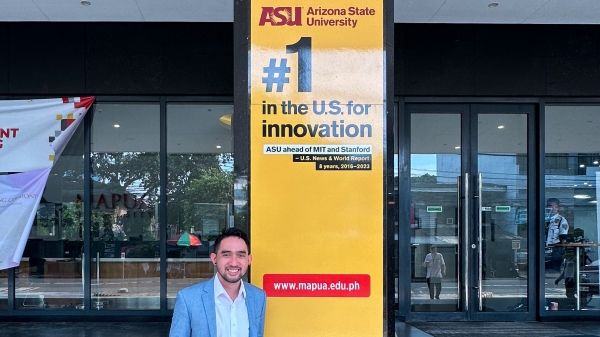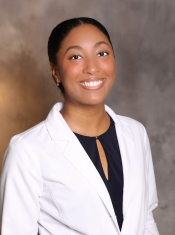ASU alum using degree to provide care for Arizona's underserved communities

ASU Nursing's DNP program prepared Davina Vea to provide care to patients who need it most. ASU photo
By Max Baker
Born and raised in Alaska, Davina Vea knows what it’s like to go without. The Arizona State University alumna was isolated not just geographically, but from family as well. Her parents were incarcerated throughout her childhood, so she moved schools a lot.
Still, she recognized early on the value of learning, not only for expanding her opportunities but also for helping others. Vea credits the Upward Bound program with helping her make it out of Alaska to eventually pursue a bachelor’s degree in nursing, a career that suited her deep desire to give back.
In 2018, she enrolled in the Doctor of Nursing Practice program at ASU’s Edson College of Nursing and Health Innovation to further her education and increase her practice authority.
“The fact that the staff were engaged and took the time to talk to me about their program stood out to me the most,” Vea said regarding her decision to choose ASU over other universities with DNPnurse practitioner programs.
The courses were challenging but worth it. After graduating in 2021, Vea got her first opportunity to work as an emergency nurse practitioner in Roswell, New Mexico. Her background helped her relate to many of her patients and her education helped her provide top-notch care.
“Sometimes when I interact with patients from underserved areas, I see a lot of my family members in them; so I was advocating for them,” Vea said.
After a year in New Mexico, Vea found herself missing Arizona. Her skills and desire to work in underserved communities were so in demand she landed not one but two jobs. She took them both and worked as an emergency nurse practitioner at Yuma Regional Medical Center and Phoenix Indian Medical Center.
For six months, Vea made the nearly 400-mile, round-trip drive from Phoenix to Yuma to maintain both positions. “It was exhausting,” she said. Eventually, Yuma Regional was able to transition her to a remote role so she could continue to work with patients there via telehealth without burning herself out.
She didn’t sit idle though; now that she was in Phoenix full time, Vea sought out additional ways to be of service and came back to Edson College as a faculty associate, working with undergraduate nursing students.
“It was important for me to help that new generation and get them excited about it, and be that professor that I wish I had when I was in undergrad,” Vea said.
Below, Vea shares some of the valuable experiences she gained in the DNP program and how it helped her become the provider she is today.
Question: How did your degree program help you in achieving and maintaining the position you have now?
Answer: The faculty in the DNP program always emphasized the importance of having the knowledge to care for your patients while teaching us how to be leaders in health care and ensuring that we take the time to listen and empathize with our patients. This program taught me the importance of holistic care. The values I've learned in this program are what's helped me become the NP I am today.
Q: What is a favorite memory from your time in your program?
A: There were so many great memories in this program, so it is hard to pick one. Building relationships with peers and faculty was amazing. I still keep in touch with them and they act as my mentors too.
Another great memory is OSCE day (Objective Structured Clinical Exams). OSCE days were recorded/graded patient interactions with NP students. This might sound like a crazy answer to most. However, I enjoyed these days because they allowed me to implement the knowledge and skills we learned. Also, it was neat to see my progress throughout the program.
Q: What advice would you give students who are currently enrolled in the program?
A: I could provide a long list of advice for students in the program, but I'll stick with the most important points. Develop a strong support system whether it's family, friends or peers in the program. You will need them when the program becomes more difficult. Always make time for self-care; this will keep you sane. Lastly, remember why you chose this program. Reflecting on your goals will help you persevere when times are tough.
Q: What were some unique challenges, if any, you had to overcome while pursuing this degree?
A: I was in school when the COVID-19 pandemic occurred, so navigating clinicals was difficult because a lot of sites stopped allowing students. Also, I was working on the COVID-19 units as a bedside RNregistered nurse . This presented its own challenges because I was always fearful of the unknown. Later on in my program, my uncle was hospitalized and eventually passed from COVID-19.
Q: What is one thing you learned from your degree program that has helped you out in your current position?
A: This is a popular quote, but it is something I always remember in my current position: "Your patients do not care what you know until they know that you care." I learned the importance of taking the time to understand my patient's unique needs and empathize with them. Basically, this summarizes what I've learned in this program.
More Health and medicine
Is ‘U-shaped happiness’ universal?
A theory that’s been around for more than a decade describes a person’s subjective well-being — or “happiness” — as having a U-shape throughout the course of one’s life. If plotted on a graph, the…
College of Health Solutions medical nutrition student aims to give back to her Navajo community
As Miss Navajo Nation, Amy N. Begaye worked to improve lives in her community by raising awareness about STEM education and health and wellness.After her one-year term ended last month, Begaye’s…

Linguistics work could improve doctor-patient communications in Philippines, beyond
When Peter Torres traveled to Mapúa University in the Philippines over the summer, he was shocked to see a billboard promoting Arizona State University.“It wasn’t even near the university,” said…
